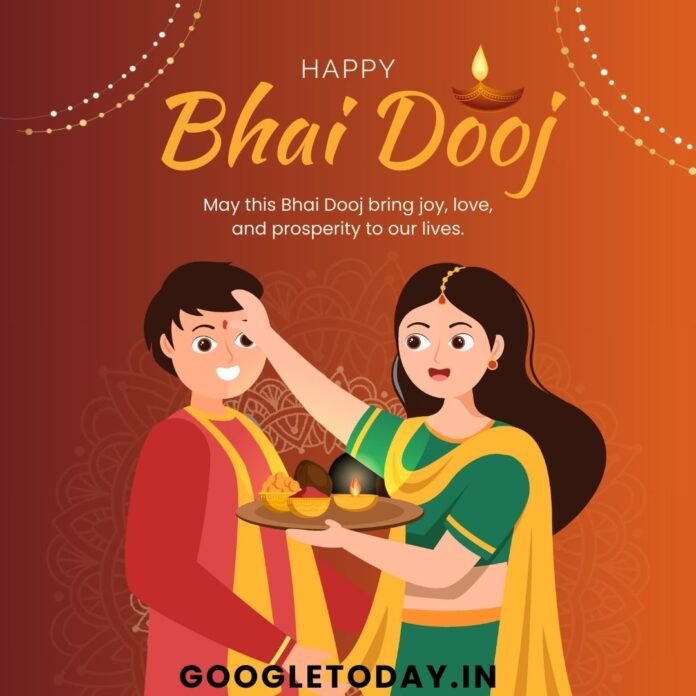Bhai Dooj, also known as Bhaiya Dooj, Bhau Beej, Bhai Phonta, or Yama Dwitiya, is a significant Hindu festival that celebrates the sacred bond between brothers and sisters. Observed on the second day of the Shukla Paksha (waxing moon) in the month of Kartika, this festival is celebrated two days after Diwali. It is a joyous occasion where siblings come together, exchange gifts, and express their love and care for each other.
Like Raksha Bandhan, It symbolizes protection, love, and familial bonds, but the emphasis lies on sisters praying for the well-being, prosperity, and longevity of their brothers. The day is marked with rituals, prayers, festive meals, and the exchange of blessings and gifts.
In this article, we will explore the mythological origins, cultural significance, rituals, regional variations, and the relevance of Bhai Dooj in the modern world. Let us read in detail On GoogleToday.in .
The Mythological Origins of Bhai Dooj
Several legends from Hindu mythology are associated with the origin of Bhai Dooj, emphasizing sibling love, protection, and togetherness.
1. The Story of Yama and Yamuna :
- According to one of the most popular legends, Bhai Dooj is linked to Yama, the god of death, and his sister Yamuna.
- The story goes that Yamuna, deeply attached to her brother, invited him several times to her home.
- However, due to his responsibilities as the lord of the underworld, Yama couldn’t visit her.
- One day, Yama decided to surprise Yamuna by accepting her invitation.
- Overjoyed, Yamuna warmly welcomed her brother, performed aarti (a ritual to ward off evil), applied tilak (sacred mark) on his forehead, and prayed for his well-being.
- In return, Yama blessed Yamuna and declared that any brother who visits his sister on this day would enjoy health, wealth, and long life.
- This event became the origin of Bhai Dooj, celebrated as a day when brothers visit their sisters to seek blessings and enjoy festive meals together.
2. The Story of Krishna and Subhadra :
- Another legend connects this with Lord Krishna and his sister Subhadra.
- After Krishna defeated the demon Narakasura, he visited Subhadra, who welcomed him by applying tilak on his forehead and performing aarti.
- Subhadra also offered him sweets, and Krishna blessed her.
- This is believed to have started the tradition of Bhai Dooj, where sisters pray for their brothers’ well-being and perform similar rituals.
The Significance of Bhai Dooj
Bhai Dooj reflects the unconditional love and trust between siblings. The festival underscores:
- Protection and Blessings: Sisters pray for their brothers’ protection and prosperity, while brothers pledge to support and care for their sisters.
- Family Unity: It strengthens familial bonds and fosters love, respect, and togetherness within the family.
- Spiritual Significance: The ritual of tilak signifies protection from evil, while the exchange of gifts symbolizes the sharing of joy.
- This also serves as an opportunity for siblings to resolve misunderstandings and renew their emotional connections, reinforcing the values of forgiveness and affection.
Bhai Dooj Rituals and Traditions
It is celebrated with simple yet meaningful rituals that vary slightly across regions. Here is a step-by-step breakdown of the traditional customs:
1. Applying the Tilak :
- The tilak ceremony is the highlight of Bhai Dooj.
- Sisters apply a red or vermilion mark on their brothers’ foreheads, accompanied by chanting prayers for their health and longevity.
- The tilak is made using a mixture of kumkum (vermilion), rice grains, and sandalwood paste.
- Symbolism: The tilak acts as a protective shield, warding off evil energies and ensuring the brother’s well-being.
2. Performing Aarti :
- After applying the tilak, sisters perform aarti to honor their brothers.
- A lit diya (oil lamp) is waved in front of the brother, symbolizing the dispelling of darkness and the invocation of divine blessings.
3. Exchange of Gifts and Sweets :
- The exchange of gifts between siblings is a cherished part of this Festival .
- Sisters often present sweets, chocolates, and thoughtful gifts to their brothers, while brothers offer return gifts as a token of love and gratitude.
4. Festive Meal and Bonding Time :
- After the rituals, the family gathers to enjoy a special meal prepared for the occasion.
- The festive meal usually includes sweets, savory snacks, and traditional delicacies enjoyed by the family together.
Regional Variations of Bhai Dooj
Bhai Dooj is celebrated across different parts of India with some regional variations in name and customs.
1. Bhai Phonta in West Bengal :
- In West Bengal, the festival is known as Bhai Phonta.
- Sisters fast until they complete the tilak ceremony for their brothers, accompanied by chanting sacred mantras.
- Special dishes like sandesh and rasgulla are prepared for the occasion.
2. Bhau Beej in Maharashtra and Goa :
- In Maharashtra and Goa, the festival is called Bhau Beej.
- Sisters welcome their brothers with a tilak and aarti and offer them puran poli, a popular Maharashtrian delicacy.
- Brothers usually give their sisters gifts or cash as a token of appreciation.
3. Yama Dwitiya in Northern India :
- In some parts of North India, Bhai Dooj is celebrated as Yama Dwitiya to honor the legend of Yama and Yamuna.
- Rituals remain similar, with a special focus on praying for the longevity of brothers.
The Importance of Bhai Dooj in Modern Times
- In today’s fast-paced world, Bhai Dooj holds greater relevance as a reminder to maintain strong familial connections.
- With families becoming more nuclear and geographically dispersed, Bhai Dooj provides a meaningful opportunity for siblings to reconnect.
- Emotional Support: The festival serves as a reminder that siblings are there to offer emotional support and guidance throughout life’s challenges.
- Reinforcing Values: Bhai Dooj nurtures values like respect, care, and trust, fostering strong interpersonal relationships.
- Reviving Traditions: It encourages people to keep traditional customs alive, reinforcing the importance of cultural heritage.
Eco-Friendly Ways to Celebrate Bhai Dooj
With rising environmental awareness, families are finding ways to celebrate Bhai Dooj in an eco-friendly manner. Here are some ideas:
- Use Natural Tilak Materials: Opt for tilak made from natural turmeric, kumkum, or sandalwood paste.
- Gift Sustainable Products: Choose gifts like handmade crafts, organic products, or reusable items.
- Minimize Waste: Use biodegradable plates and cups for meals and avoid single-use plastic decorations.
Bhai Dooj vs. Raksha Bandhan: Similarities and Differences
While both Bhai Dooj and Raksha Bandhan celebrate the bond between siblings, there are some key differences:
| Aspect | Bhai Dooj | Raksha Bandhan |
|---|---|---|
| Occasion | Celebrated after Diwali | Celebrated in the month of Shravan (July-August) |
| Ritual | Sisters apply tilak and perform aarti | Sisters tie a rakhi (sacred thread) on brothers’ wrists |
| Focus | Prayers for brother’s longevity | Brother’s vow to protect his sister |
| Gifts | Gifts exchanged between siblings | Brothers give gifts to sisters |
Conclusion: Celebrating Love, Protection, and Togetherness
- This is more than just a festival—it is a celebration of love, care, and lifelong support between siblings.
- It teaches the importance of gratitude, protection, and mutual respect in relationships.
- In an era where personal connections can easily get lost amidst busy schedules, Bhai Dooj provides a chance for siblings to reconnect and cherish their bond.
- Whether celebrated with traditional rituals or modern twists, Bhai Dooj continues to be an enduring symbol of sibling affection and family unity.
- By fostering love and strengthening familial ties, the festival ensures that the spirit of togetherness remains alive across generations.

